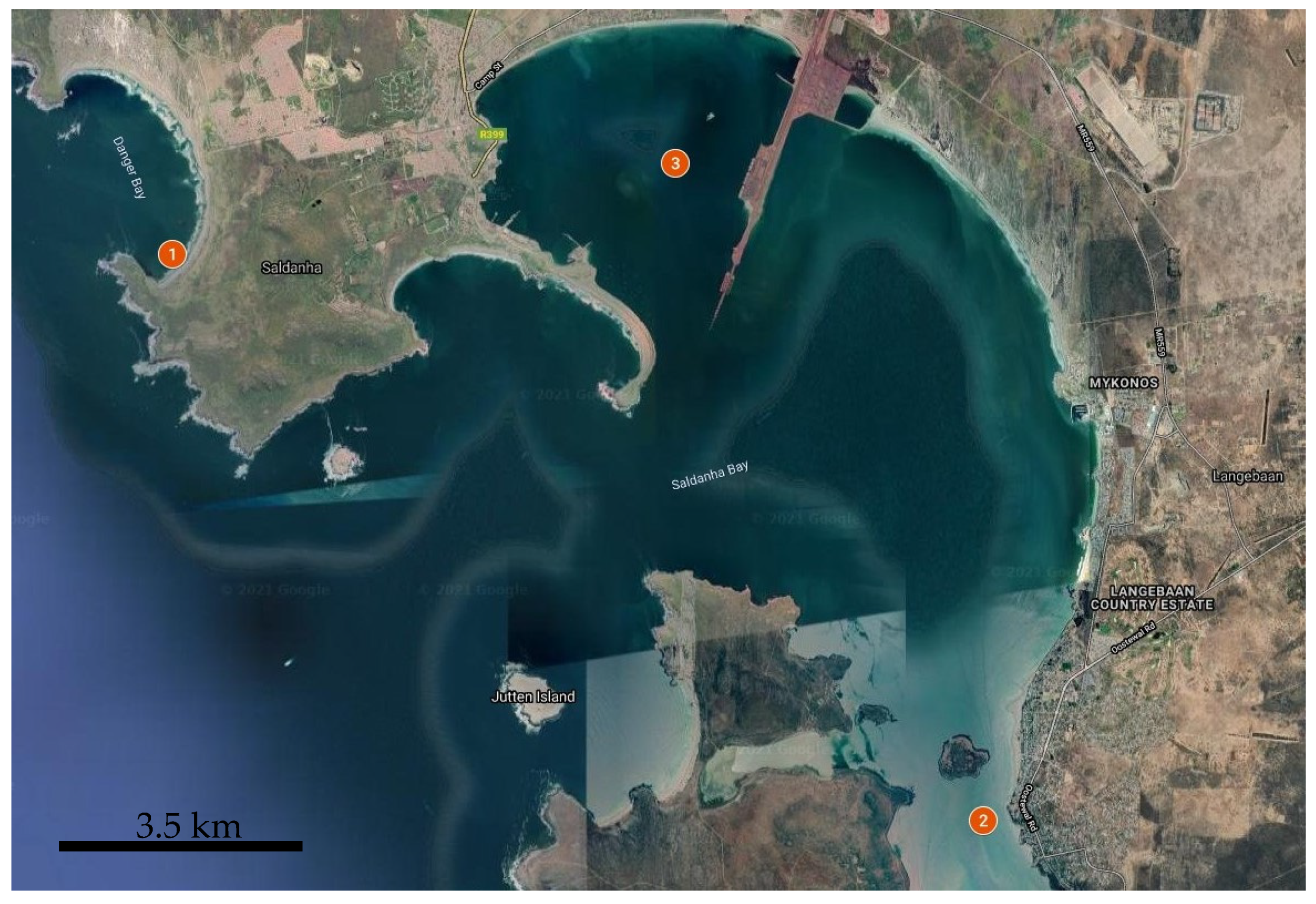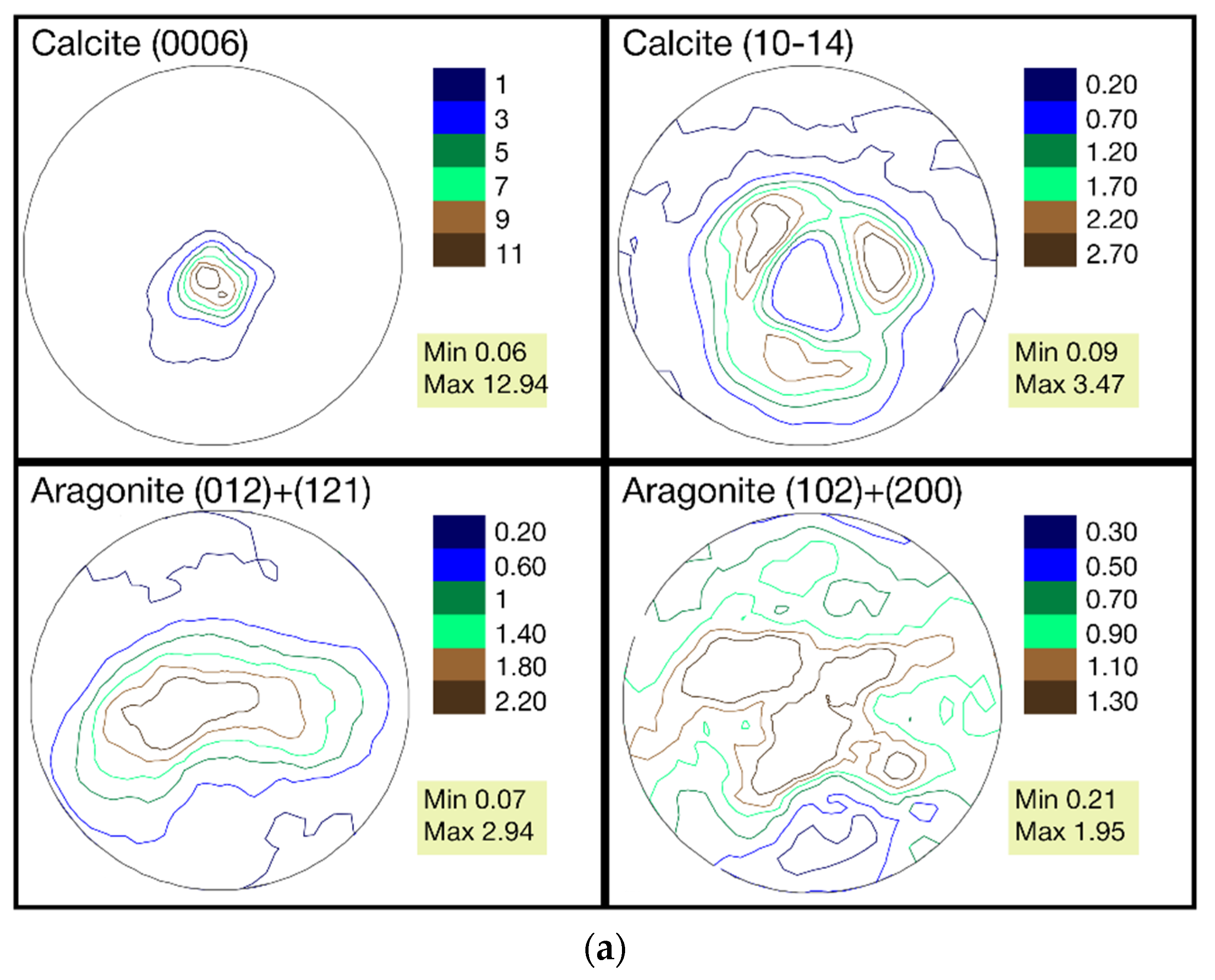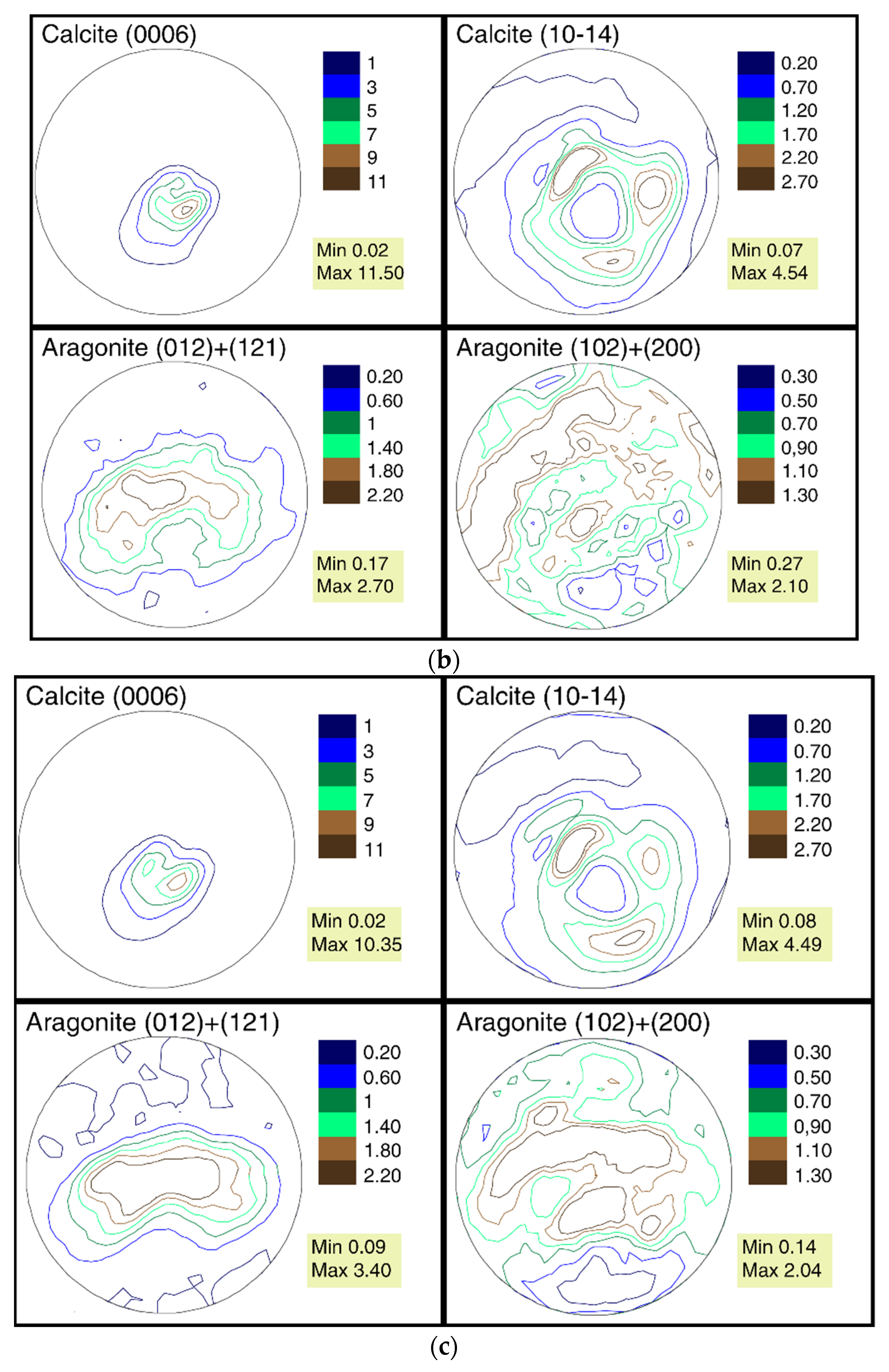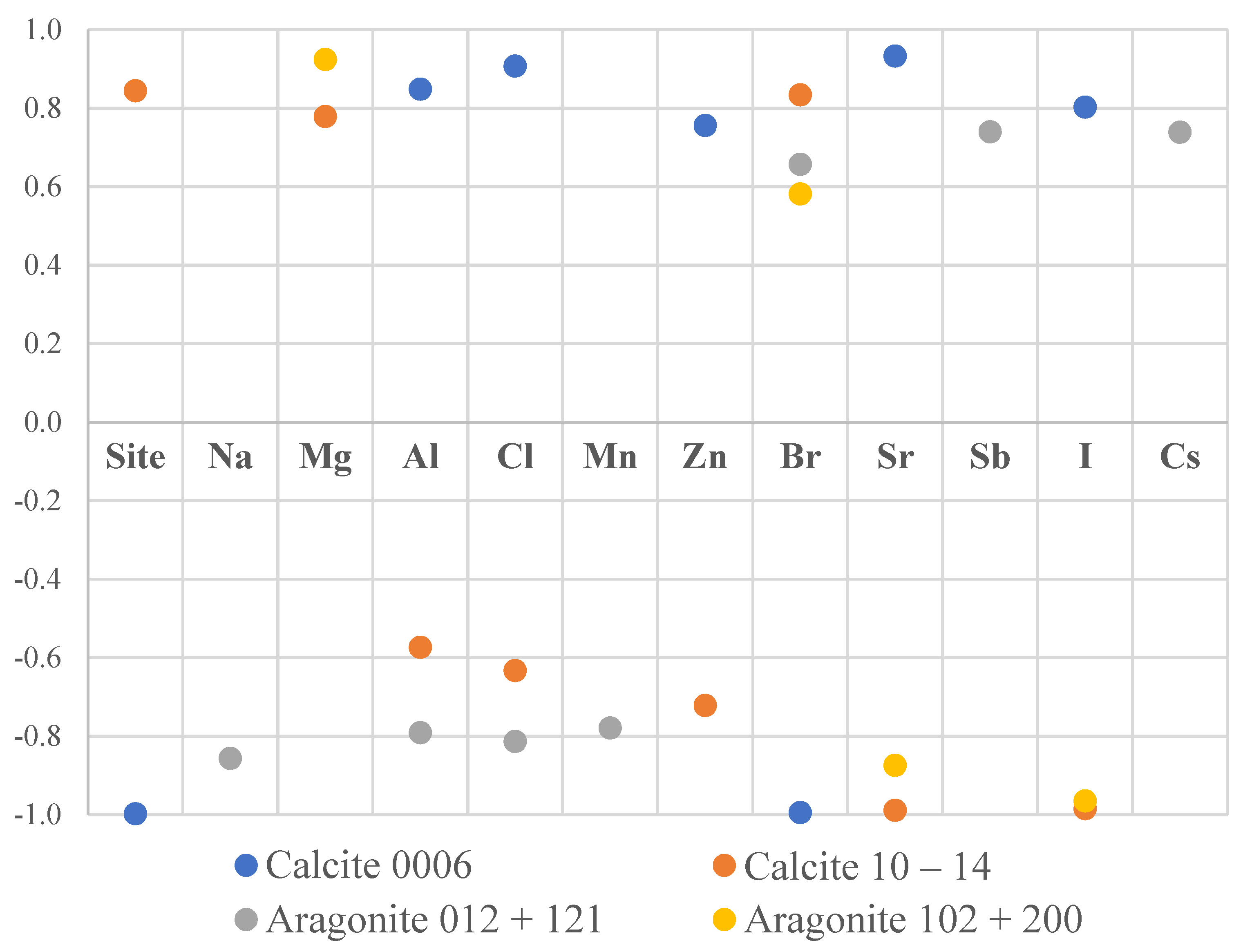Effect of the Elemental Content of Shells of the Bivalve Mollusks (Mytilus galloprovincialis) from Saldanha Bay (South Africa) on Their Crystallographic Texture
Abstract
:Simple Summary
Abstract
1. Introduction
2. Materials and Methods
2.1. Sampling
2.2. Characterization of the Environmental Parameters
2.3. Elemental Analysis
2.4. Crystallographic Texture Analysis of Minerals of Shells
2.5. Statistics
3. Results and Discussion
3.1. Elemental Content of Shells and Soft Tissues and Allometry
3.2. Environmental Features Based on Element/Na and Element/Ca Ratios
3.3. Crystallographic Texture Results
- Calcite (0006) correlated with Al, Cl, Zn, Sr, I (r > 0.75, p < 0.02) and inversely correlated with Br (r < −0.8, p < 0.001).
- Calcite (10–14) correlated with Mg, Br (r > 0.75, p < 0.03) and inversely correlated with Zn, Sr, I (r < −0.7, p < 0.3).
- Aragonite (012) + (121) correlated with Sb, Cs (r > 0.7, p < 0.02) and inversely correlated with Na, Al, Cl, Mn (r < −07, p < 0.01).
- Aragonite (102) + (200) correlated with Mg (r > 0.9, p < 0.001) and inversely correlated with Sr, I (r < −0.8, p < 0.002).
4. Conclusions
Author Contributions
Funding
Institutional Review Board Statement
Informed Consent Statement
Data Availability Statement
Acknowledgments
Conflicts of Interest
References
- Freitas, P.; Clarke, L.J.; Kennedy, H.; Richardson, C.; Abrantes, F. Mg/Ca, Sr/Ca, and stable-isotope (δ18O and δ13C) ratio profiles from the fan mussel Pinna nobilis: Seasonal records and temperature relationships. Geochem. Geophys. Geosyst. 2005, 6, 1–16. [Google Scholar] [CrossRef]
- Carré, M.; Bentaleb, I.; Bruguier, O.; Ordinola, E.; Barrett, N.T.; Fontugne, M. Calcification rate influence on trace element concentrations in aragonitic bivalve shells: Evidences and mechanisms. Geochim. Cosmochim. Acta 2006, 70, 4906–4920. [Google Scholar] [CrossRef]
- Hahn, S.; Rodolfo-Metalpa, R.; Griesshaber, E.; Schmahl, W.W.; Buhl, D.; Hall-Spencer, J.M.; Immenhauser, A. Marine bivalve shell geochemistry and ultrastructure from modern low pH environments: Environmental effect versus experimental bias. Biogeosciences 2012, 9, 1897–1914. [Google Scholar] [CrossRef] [Green Version]
- Fatoki, O.S.; Okoro, H.K.; Adekola, F.A.; Ximba, B.J.; Snyman, R.G. Bioaccumulation of metals in black mussels (Mytilus galloprovincialis) in Cape Town Harbour, South Africa. Environmentalist 2012, 32, 48–57. [Google Scholar] [CrossRef]
- Rončević, S.; Pitarević Svedružić, L.; Smetiško, J.; Medaković, D. ICP-AES analysis of metal content in shell of mussel Mytilus galloprovincialis from Croatian coastal waters. Int. J. Environ. Anal. Chem. 2010, 90, 620–632. [Google Scholar] [CrossRef]
- Grenier, C.; Román, R.; Duarte, C.; Navarro, J.M.; Rodriguez-Navarro, A.B.; Ramajo, L. The combined effects of salinity and pH on shell biomineralization of the edible mussel Mytilus chilensis. Environ. Pollut. 2020, 263, 114555. [Google Scholar] [CrossRef]
- Zinicovscaia, I.; Pavlov, S.S.; Frontasyeva, M.V.; Ivlieva, A.L.; Petritskaya, E.N.; Rogatkin, D.A.; Demin, V.A. Accumulation of silver nanoparticles in mice tissues studied by neutron activation analysis. J. Radioanal. Nucl. Chem 2018, 318, 985–989. [Google Scholar] [CrossRef]
- Eichelkraut, H.; Hirsch, J.; Lucke, K. Rolling and recrystallization textures in copper-germanium alloys. Int. J. Mater. Res. 1984, 75, 113–123. [Google Scholar] [CrossRef]
- Clark, B.M.; Massie, V.; Hutchings, K.; Biccard, A.; Brown, E.; Laird, M.; Gihwala, K.; Swart, C.; Makhosonke, A.; Sedick, S.; et al. The State of Saldanha Bay and Langebaan Lagoon 2019; Technical Report. Report No. AEC 1841/1 Prepared by Anchor Environmental Consultants (Pty) Ltd. for the Saldanha Bay Water Quality Forum Trust; Anchor Environmental Consultants: Cape Town, South Africa, 2019. [Google Scholar]
- Clark, B.M.; Massie, V.; Hutchings, K.; Laird, M.; Biccard, A.; Brown, E.; Duna, O.O.; Turpie, J. The State of Saldanha Bay and Langebaan Lagoon 2016; Technical Report. Report No. AEC 1691/1 prepared by Anchor Environmental Consultants (Pty) Ltd. for the Saldanha Bay Water Quality Forum Trust; Anchor Environmental Consultants: Cape Town, South Africa, 2016. [Google Scholar]
- Degger, N.; Wepener, V.; Richardson, B.J.; Wu, R.S.S. Application of artificial mussels (AMs) under South African marine conditions: A validation study. Mar. Pollut. Bull. 2011, 63, 108–118. [Google Scholar] [CrossRef] [PubMed]
- Firth, D.C.; Salie, K.; O’Neill, B.; Hoffman, L.C. Monitoring of trace metal accumulation in two South African farmed mussel species, Mytilus galloprovincialis and Choromytilus meridionalis. Mar. Pollut. Bull. 2019, 141, 529–534. [Google Scholar] [CrossRef] [PubMed]
- Bezuidenhout, J.; Dames, N.; Botha, A.; Frontasyeva, M.V.; Goryainova, Z.I.; Pavlov, D. Trace elements in Mediterranean mussels Mytilus galloprovincialis from the South African west coast. Ecol. Chem. Eng. 2015, 22, 489–498. [Google Scholar] [CrossRef] [Green Version]
- Bezuidenhout, J.; Nekhoroshkov, P.; Zinicovscaia, I.; Yushin, N.; Frontasyeva, M. Accumulation Features of Micro and Macroelements in Indigenous and Alien Molluscs in Saldanha Bay, South Africa. Ecol. Chem. Eng. 2020, 27, 495–508. [Google Scholar] [CrossRef]
- Pavlov, D.F.; Bezuidenhout, J.; Frontasyeva, M.V.; Goryainova, Z.I. Differences in trace element content between non-indigenous farmed and invasive bivalve mollusks of the South African Coast. Am. J. Anal. Chem. 2015, 6, 886. [Google Scholar] [CrossRef] [Green Version]
- Nekhoroshkov, P.S.; Bezuidenhout, J.; Frontasyeva, M.V.; Zinicovscaia, I.I.; Yushin, N.S.; Vergel, K.N.; Petrik, L. Trace elements risk assessment for consumption of wild mussels along South Africa coastline. J. Food Compos. Anal. 2021, 98, 103825. [Google Scholar] [CrossRef]
- Sparks, C.; Odendaal, J.; Snyman, R. An analysis of historical Mussel Watch Programme data from the west coast of the Cape Peninsula, Cape Town. Mar. Pollut. Bull. 2014, 87, 374–380. [Google Scholar] [CrossRef]
- Lauzon-Guay, J.S.; Hamilton, D.J.; Barbeau, M.A. Effect of Mussel Density and Size on the Morphology of Blue Mussels (Mytilus Edulis) Grown in Suspended Culture in Prince Edward Island, Canada. Aquaculture 2005, 249, 265–274. [Google Scholar] [CrossRef]
- Lobel, P.B.; Bajdik, C.D.; Belkhode, S.P.; Jackson, S.E.; Longerich, H.P. Improved protocol for collecting mussel watch specimens taking into account sex, size, condition, shell shape, and chronological age. Arch. Environ. Contam. Toxicol. 1991, 21, 409–414. [Google Scholar] [CrossRef]
- Wright, A.G.; Massie, V.; Clark, B.M.; Brown, E. Terrestrial and Marine Biodiversity Impact Assessment for the Proposed Upgrade of the Stormwater Management System, Port of Saldanha, South Africa; Report Prepared by Anchor Environmental Consultants (Pty) Ltd. for Nsovo Environmental; Consulting Report No. 1769/5; Anchor Environmental Consultants: Cape Town, South Africa, 2018; 60p. [Google Scholar]
- Monteiro, P.M.S.; Pascall, A.; Brown, S. The Biogeochemical Status of Near-Surface Sediments in Saldanha Bay in 1999. CSIR Rep. 1999. [Google Scholar]
- Pavlov, S.S.; Dmitriev, A.Y.; Frontasyeva, M.V. Automation system for neutron activation analysis at the reactor IBR-2, Frank Laboratory of neutron physics, Joint Institute for Nuclear Research, Dubna, Russia. J. Radioanal. Nucl. Chem. 2016, 309, 27–38. [Google Scholar] [CrossRef] [Green Version]
- Greenberg, R.R.; Bode, P.; Fernandes, E.A.D.N. Neutron activation analysis: A primary method of measurement. Spectrochim. Acta Part B At. Spectrosc. 2011, 66, 193–241. [Google Scholar] [CrossRef]
- Nikolaev, D.; Lychagina, T.; Pakhnevich, A. Experimental neutron pole figures of minerals composing the bivalve mollusc shells. Springer Nat. Appl. Sci. 2019, 1, 344. [Google Scholar] [CrossRef] [Green Version]
- Keppler, R.; Ullemeyer, K.; Behrmann, J.H.; Stipp, M. Potential of full pattern fit methods for the texture analysis of geological materials: Implications from texture measurements at the recently upgraded neutron time-of-flight diffractometer SKAT. J. Appl. Crystallogr. 2014, 47, 1520–1534. [Google Scholar] [CrossRef]
- Nikolayev, D.I.; Lychagina, T.A.; Nikishin, A.V.; Yudin, V.V. Investigation of measured pole figures errors. Mater. Sci. Forum. 2005, 495–497, 307–312. [Google Scholar] [CrossRef]
- Nikolayev, D.I.; Lychagina, T.A.; Nikishin, A.V.; Yudin, V.V. Study of error distribution in measured pole figures. Solid State Phenom. 2005, 105, 77–82. [Google Scholar] [CrossRef]
- Nikolayev, D.I.; Ullemeyer, K. A Note on Preprocessing of Diffraction Pole Density Data. J. Appl. Cryst. 1994, 27, 517–520. [Google Scholar] [CrossRef]
- Zar, J.H. Critical values for Fisher’s exact test. In Biostatistical Analysis; Prentice-Hall: Englewood Cliffs, NJ, USA, 1984; pp. 220–242. [Google Scholar]
- Uğur, A.; Yener, G.; Başsarı, A. Trace metals and 210Po (210Pb) concentrations in mussels (Mytilus galloprovincialis) consumed at western Anatolia. Appl. Radiat. Isot. 2002, 57, 565–571. [Google Scholar] [CrossRef]
- De los Ríos, A.; Pérez, L.; Ortiz-Zarragoitia, M.; Serrano, T.; Barbero, M.C.; Echavarri-Erasun, B.; Juanes, J.A.; Orbea, A.; Cajaraville, M.P. Assessing the effects of treated and untreated urban discharges to estuarine and coastal waters applying selected biomarkers on caged mussels. Mar. Pollut. Bull. 2013, 77, 251–265. [Google Scholar] [CrossRef]
- Signa, G.; Di Leonardo, R.; Vaccaro, A.; Tramati, C.D.; Mazzola, A.; Vizzini, S. Lipid and fatty acid biomarkers as proxies for environmental contamination in caged mussels Mytilus galloprovincialis. Ecol. Indic. 2015, 57, 384–394. [Google Scholar] [CrossRef]
- Richir, J.; Gobert, S. The effect of size, weight, body compartment, sex and reproductive status on the bioaccumulation of 19 trace elements in rope-grown Mytilus galloprovincialis. Ecol. Indic. 2014, 36, 33–47. [Google Scholar] [CrossRef]
- Yap, C.K.; Sharifinia, M.; Cheng, W.H.; Al-Shami, S.A.; Wong, K.W.; Al-Mutairi, K.A. A Commentary on the Use of Bivalve Mollusks in Monitoring Metal Pollution Levels. Int. J. Environ. Res. Public Health 2021, 18, 3386. [Google Scholar] [CrossRef] [PubMed]
- Nauen, C.E. Compilation of Legal Limits for Hazardous Substances in Fish and Fishery Products; No. 764; FAO Fisheries Circular (FAO): Rome, Italy, 1983. [Google Scholar]
- Department of Health (DOH). Regulations Relating to Maximum Levels for Metals in No. R.500; Department of Health: Hong Kong, 2004.
- Lazareth, C.E.; Vander Putten, E.; André, L.; Dehairs, F. High-resolution trace element profiles in shells of the mangrove bivalve Isognomon ephippium: A record of environmental spatio-temporal variations? Estuar. Coast. Shelf Sci. 2003, 57, 1103–1114. [Google Scholar] [CrossRef]
- Vander Putten, E.; Dehairs, F.; Keppens, E.; Baeyens, W. High resolution distribution of trace elements in the calcite shell layer of modern Mytilus edulis: Environmental and biological controls. Geochim. Cosmochim. Acta 2000, 64, 997–1011. [Google Scholar] [CrossRef]
- Bunge, H.J. Texture Analysis in Material Science, Mathematical Methods; Elsevier: London, UK, 1982; 595p. [Google Scholar]
- Matthies, S.; Vinel, G.W.; Helming, K. Standard Distributions in Texture Analysis: Maps for the Case of Cubic-Orthorhombic Symmetry; De Gruyter Akademie Forschung: Berlin, Germany, 1987; Volume 1. [Google Scholar]





| Elements | Standard Reference Materials (SRMs) | Concentrations, ppm | Uncertainties, % | Deviation, % | ||
|---|---|---|---|---|---|---|
| Determined | Certified | Determined | Certified | |||
| Na | 2711a | 11,900 | 12,000 | 8.8 | 0.01 | 0.5 |
| Mg | 063R | 1320 | 1263 | 7.6 | 2 | 4.6 |
| Al | 1633c | 129,900 | 132,800 | 6.9 | 4.6 | 2.2 |
| Cl | 1632d | 1150 | 1142 | 7.8 | 1 | 0.3 |
| K | FFA1 | 23,420 | 22,000 | 11.3 | 30 | 6.4 |
| Ca | 2710a | 9450 | 9640 | 18.9 | 4.7 | 1.9 |
| Sc | 667 | 13.6 | 13.7 | 5.3 | 5.1 | 0.4 |
| V | 1632d | 23.8 | 23.7 | 5.7 | 0.4 | 0.1 |
| Cr | 2711a | 53.2 | 52.3 | 11.5 | 6 | 1.7 |
| Mn | 1549 | 0.27 | 0.26 | 15 | 23.1 | 4.2 |
| Fe | 2711a | 27,900 | 28,200 | 5.5 | 0.04 | 1.2 |
| Co | 2711a | 10 | 9.9 | 5.6 | 2 | 1.1 |
| Ni | 667 | 126 | 128 | 10.3 | 7 | 1.4 |
| Zn | 667 | 177 | 175 | 4.5 | 7.4 | 0.9 |
| As | 2711a | 102 | 107 | 6 | 5 | 4.8 |
| Se | FFA1 | 4.4 | 4.6 | 39.1 | 30 | 3.3 |
| Br | 667 | 82.8 | 99.7 | 4.4 | 2.5 | 16.9 |
| Rb | 2711a | 126 | 120 | 16.6 | 3 | 4.7 |
| Sr | FFA1 | 252 | 250 | 11.3 | 5.2 | 0.8 |
| Sb | FFA1 | 18.4 | 17.6 | 7.6 | 14.2 | 4.6 |
| I | 1549 | 3.1 | 3.4 | 15.3 | 0.6 | 7.4 |
| Cs | 667 | 7.9 | 7.8 | 4.3 | 9 | 0.8 |
| Th | 667 | 10.2 | 10 | 4.7 | 5 | 2.1 |
| U | 667 | 2.31 | 2.26 | 3.3 | 6.6 | 2.1 |
| Elements | Shells | Soft Tissues | ||||||||||
|---|---|---|---|---|---|---|---|---|---|---|---|---|
| St. 1 | St. 2 | St. 3 | St. 1 | St. 2 | St. 3 | |||||||
| Min-Max | CV | Min-Max | CV | Min-Max | CV | Min-Max | CV | Min-Max | CV | Min-Max | CV | |
| Na | 0.4–0.46 | 7 | 0.46–0.50 | 4 | 0.38–0.40 | 3 | 5.1–5.4 | 3 | 3.8–3.9 | 1 | 1.96–2.01 | 1 |
| Mg | 770–840 | 5 | 1040–1150 | 5 | 860–960 | 6 | 7000–7600 | 4 | 5500–6500 | 8 | 2860–3270 | 7 |
| Al | 39–52 | 15 | 33–46 | 17 | 15–23 | 26 | 159–203 | 13 | 444–480 | 4 | 63–71 | 6 |
| Cl | 790–850 | 3.7 | 720–820 | 7.3 | 530–560 | 2.8 | 81,000–86,000 | 3 | 61,000–62,000 | 1 | 29,700–33,100 | 6 |
| K | <DL | <DL | <DL | 7400–8500 | 7 | 6700–10,400 | 22 | 8700–10,400 | 10 | |||
| Ca, % | 3.-37 | 2.8 | 33–38 | 7.1 | 37–39 | 2.6 | 1.02–1.16 | 7 | 1.15–1.22 | 3 | 0.69–0.79 | 7 |
| Sc | 0.04–0.07 | 39 | 0.03–0.04 | 11 | 0.04–0.07 | 28 | 0.037–0.061 | 25 | 0.12–0.13 | 7 | 0.018–0.033 | 32 |
| V | 0.2–0.3 | 18 | 0.2–0.3 | 20 | 0.3–0.3 | 7 | 1.25–1.41 | 6 | 0.62–1.46 | 49 | 0.66–0.9 | 16 |
| Cr | 1.2–1.9 | 23 | 0.9–1.6 | 28 | 1.5–1.7 | 7 | 3.2–3.8 | 9 | 2.4–2.6 | 5 | 1.1–2.6 | 45 |
| Mn | 1.57–2.2 | 17 | 1.74–2.16 | 11 | 1.37–1.5 | 5 | 3.76–5.7 | 25 | 5–6.6 | 16 | 3.42–5.4 | 26 |
| Fe | 112–207 | 31 | 78–119 | 21 | 84–146 | 27 | 421–470 | 6 | 390–420 | 4 | 99–136 | 17 |
| Co | 0.09–0.14 | 28 | 0.06–0.12 | 33 | 0.04–0.11 | 48 | 0.46–0.52 | 7 | 0.225–0.26 | 9 | 0.128–0.136 | 3 |
| Ni | 0.4–0.6 | 24 | 0.1–0.6 | 78 | 0.2–0.6 | 50 | 3.1–4.7 | 24 | 0.83–1.51 | 30 | 0.75–0.82 | 4 |
| Zn | 4–4.3 | 4 | 3–3.9 | 13 | 2.62–3.77 | 18 | 230–232 | 0.4 | 105–108 | 1.6 | 121–124 | 1.2 |
| As | <DL | <DL | <DL | 8.3–8.6 | 2 | 5.3–5.8 | 5 | 5.7–6.2 | 4 | |||
| Se | <DL | <DL | <DL | 4.9–5.2 | 3 | 7–7.2 | 1 | 5–5.3 | 3 | |||
| Br | 64–68 | 4 | 88–89 | 1 | 111–113 | 1 | 463–467 | 0.4 | 289–291 | 0.3 | 163–165 | 0.6 |
| Rb | 3.5–3.8 | 5 | 4.9–5.2 | 3 | 3.9–4.2 | 4 | ||||||
| Sr | 1500–1550 | 2 | 1090–1100 | 1 | 1030–1050 | 1 | 133–136 | 1 | 98–99 | 1 | 52–53 | 1 |
| Sb | 0.02–0.04 | 32 | 0.01–0.03 | 39 | 0.03–0.06 | 34 | 0.042–0.057 | 15 | 0.021–0.033 | 24 | 0.0145–0.0206 | 19 |
| I | 12–13 | 3 | 5–5 | 2 | 6–7 | 12 | 56–57 | 1 | 12.3–13.7 | 5 | 4.8–5.7 | 9 |
| Cs | 0.05–0.08 | 29 | 0.04–0.05 | 13 | 0.05–0.12 | 39 | 0.031–0.037 | 9 | 0.081–0.091 | 6 | 0.024–0.038 | 24 |
| Th | 0.05–0.09 | 26 | 0.05–0.06 | 12 | 0.05–0.1 | 33 | 0.05–0.05 | 0.1 | 0.106–0.109 | 1.6 | 0.024–0.094 | 28 |
| U | 0.11–0.17 | 25 | 0.04–0.06 | 29 | 0.04–0.17 | 58 | 0.68–0.97 | 19 | 0.19–0.36 | 31 | 0.27–0.31 | 7 |
| Elements | Saldanha Zone | [4] | [5] | ||
|---|---|---|---|---|---|
| Danger Bay | Langebaan | Small Bay | Cape Town | Adriatic | |
| Mean ± SD | Mean ± SD | Mean ± SD | Mean ± SE | Range | |
| Na | 4300 ± 300 | 4767 ± 210 | 3933 ± 120 | - | 2500–4000 |
| Mg | 797 ± 38 | 1100 ± 56 | 913 ± 50 | - | 800–1400 |
| Al | 45 ± 6.6 | 39 ± 6.6 | 18 ± 0.1 | 3730 ± 960 | 2.5–27 |
| Cl | 823 ± 30 | 757 ± 60 | 543 ± 20 | - | - |
| Ca, % | 36 ± 1 | 35.3 ± 2.5 | 38 ± 1 | 12.6 ± 1.2 | 35–37 |
| Sc | 0.05 ± 0.002 | 0.03 ± 0.004 | 0.06 ± 0.002 | - | - |
| V | 0.3 ± 0.04 | 0.2 ± 0.05 | 0.3 ± 0.02 | 3.9 ± 0.2 | - |
| Cr | 1.6 ± 0.4 | 1.3 ± 0.4 | 1.6 ± 0.1 | 8.4 ± 0.1 | - |
| Mn | 1.9 ± 0.3 | 2 ± 0.2 | 1.4 ± 0.1 | 27.7 ± 1.3 | 2–155 |
| Fe | 155 ± 25 | 98 ± 21 | 116 ± 31 | 1360 ± 140 | 15–550 |
| Co | 0.1 ± 0.03 | 0.09 ± 0.03 | 0.09 ± 0.04 | 0.72 ± 0.01 | - |
| Ni | 0.5 ± 0.12 | 0.3 ± 0.23 | 0.4 ± 0.21 | 3.56 ± 0.04 | 7–33 |
| Zn | 4 ± 0.2 | 3 ± 0.5 | 3 ± 0.6 | 142 ± 13 | 2.5–15 |
| Br | 67 ± 2 | 89 ± 1 | 112 ± 1 | - | - |
| Sr | 1523 ± 25 | 1093 ± 6 | 1043 ± 12 | 365 ± 7 | 500–800 |
| Sb | 0.03 ± 0.009 | 0.02 ± 0.008 | 0.04 ± 0.015 | - | - |
| I | 13 ± 0.4 | 5 ± 0.1 | 6 ± 0.8 | - | - |
| Cs | 0.06 ± 0.02 | 0.04 ± 0.01 | 0.1 ± 0.04 | - | - |
| Th | 0.07 ± 0.02 | 0.06 ± 0.01 | 0.08 ± 0.03 | - | - |
| U | 0.13 ± 0.03 | 0.05 ± 0.01 | 0.12 ± 0.07 | - | - |
| Elements | Out Study, Saldanha Zone | [30] Min-Max | [31] Min-Max | [32] Min-Max | [16] Mean ± SD | [33] Min-Max | [4] Mean ± SE |
|---|---|---|---|---|---|---|---|
| Min-Max | |||||||
| Na | 19,600–54,000 | 29,550 ± 5350 | |||||
| Mg | 2860–7600 | 6960 ± 1040 | |||||
| Al | 63–480 | 134 ± 53 | 39–877 | ||||
| Cl | 29,700–86,000 | 6660 ± 1920 | 4330 ± 180 | ||||
| K | 6700–10,400 | 3.69 ± 0.05 | |||||
| Ca, % | 0.69–1.22 | 1.02 ± 0.70 | |||||
| Sc | 0.02–0.13 | 0.035 ± 0.014 | 2.3–12.5 | 3.3 ± 0.3 | |||
| V | 0.6–1.5 | 11–59 | 0.63 ± 0.24 | 0.19–2.17 | 5.9 ± 0.2 | ||
| Cr | 1.1–3.8 | 0.9–4.7 | 12–25 | 1.7 ± 0.4 | 3.4–20.6 | 23.2 ± 1.5 | |
| Mn | 3.4–6.6 | 125–144 | 3.92 ± 0.99 | 66–656 | 1150 ± 150 | ||
| Fe | 99–470 | 98–685 | 52–215 | 171 ± 51 | 0.37–1.37 | 0.70 ± 0.02 | |
| Co | 0.1–0.5 | 3–158 | 0.21 ± 0.03 | 0.71–3.39 | 1.78 ± 0.02 | ||
| Ni | 0.8–4.7 | 0.2–1.5 | 20–39 | 1.1 ± 0.24 | 35–224 | 204 ± 15 | |
| Zn | 105–232 | 117–423 | 85–284 | 23–265 | 309 ± 105 | 17–46 | 9.2 ± 0.1 |
| As | 5.3–8.6 | 1.3–15.6 | 7.7 ± 1.6 | 1.5–4.3 | |||
| Se | 4.9–7.2 | 2.7 ± 0.3 | |||||
| Br | 163–467 | 91–460 | 350 ± 58 | ||||
| Rb | 3.5–5.2 | 3.1 ± 0.52 | 209 ± 5 | ||||
| Sr | 52–136 | 18–67 | 77 ± 50 | 0.007–0.028 | |||
| Sb | 0.01–0.06 | 0.02 ± 0.005 | |||||
| I | 4.8–57 | 46.7 ± 8.2 | |||||
| Cs | 0.02–0.09 | 0.024 ± 0.009 | |||||
| Th | 0.02–0.11 | 0.034 ± 0.012 | |||||
| U | 0.2–1.0 | 0.4 ± 0.07 |
| Parameters | St. 1 Danger Bay | St. 2 Langebaan | St. 3 Small Bay |
|---|---|---|---|
| Mass/Length | 0.03 | 0.05 | 0.09 |
| Width/Height | 0.96 | 0.69 | 0.84 |
| CI | 17.7 | 16.6 | 22.1 |
| Pole Figures (PF) | Calcite (0006) | Calcite (10–14) | Aragonite (012) + (121) | Aragonite (102) + (200) | ||||
|---|---|---|---|---|---|---|---|---|
| Station | 2 | 3 | 2 | 3 | 2 | 3 | 2 | 3 |
| 1 | 32.7 | 38.3 | 9.1 | 14.7 | 7.2 | 14.4 | 5.0 | 2.9 |
Publisher’s Note: MDPI stays neutral with regard to jurisdictional claims in published maps and institutional affiliations. |
© 2021 by the authors. Licensee MDPI, Basel, Switzerland. This article is an open access article distributed under the terms and conditions of the Creative Commons Attribution (CC BY) license (https://creativecommons.org/licenses/by/4.0/).
Share and Cite
Nekhoroshkov, P.; Zinicovscaia, I.; Nikolayev, D.; Lychagina, T.; Pakhnevich, A.; Yushin, N.; Bezuidenhout, J. Effect of the Elemental Content of Shells of the Bivalve Mollusks (Mytilus galloprovincialis) from Saldanha Bay (South Africa) on Their Crystallographic Texture. Biology 2021, 10, 1093. https://doi.org/10.3390/biology10111093
Nekhoroshkov P, Zinicovscaia I, Nikolayev D, Lychagina T, Pakhnevich A, Yushin N, Bezuidenhout J. Effect of the Elemental Content of Shells of the Bivalve Mollusks (Mytilus galloprovincialis) from Saldanha Bay (South Africa) on Their Crystallographic Texture. Biology. 2021; 10(11):1093. https://doi.org/10.3390/biology10111093
Chicago/Turabian StyleNekhoroshkov, Pavel, Inga Zinicovscaia, Dmitry Nikolayev, Tatiana Lychagina, Alexey Pakhnevich, Nikita Yushin, and Jacques Bezuidenhout. 2021. "Effect of the Elemental Content of Shells of the Bivalve Mollusks (Mytilus galloprovincialis) from Saldanha Bay (South Africa) on Their Crystallographic Texture" Biology 10, no. 11: 1093. https://doi.org/10.3390/biology10111093
APA StyleNekhoroshkov, P., Zinicovscaia, I., Nikolayev, D., Lychagina, T., Pakhnevich, A., Yushin, N., & Bezuidenhout, J. (2021). Effect of the Elemental Content of Shells of the Bivalve Mollusks (Mytilus galloprovincialis) from Saldanha Bay (South Africa) on Their Crystallographic Texture. Biology, 10(11), 1093. https://doi.org/10.3390/biology10111093








